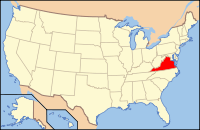Temple Hall
|
Temple Hall | |
 | |
 | |
| Location |
Loudoun County, at 15764 Temple Hall Lane Leesburg, Virginia |
|---|---|
| Coordinates | 39°10′54.39″N 77°31′43.55″W / 39.1817750°N 77.5287639°WCoordinates: 39°10′54.39″N 77°31′43.55″W / 39.1817750°N 77.5287639°W |
| Area | 286 acres (116 ha) |
| Built | 1810 |
| Architect | Unknown |
| Architectural style | Federal style |
| Governing body | Local |
| NRHP Reference # | 07000053[1] |
| VLR # | 053-0303 |
| Significant dates | |
| Added to NRHP | February 13, 2007 |
| Designated VLR | September 6, 2006; May 15, 2007[2] |
Temple Hall is an early 19th-century Federal-style mansion and working farm near the Potomac River north of Leesburg in Loudoun County, Virginia.
History
Temple Hall was constructed in 1810[3] for William Temple Thomson Mason (24 July 1782–1862),[4] a son of Thomson Mason and his second wife Elizabeth Westwood Wallace of nearby Raspberry Plain, and nephew of George Mason.[5] The estate became a hub of Leesburg society[6] and was visited by Gilbert du Motier, marquis de Lafayette during his grand tour of the United States on 9 August 1825.[5][6] Lafayette was accompanied by President John Quincy Adams and former President James Monroe, who was then residing at his Oak Hill plantation in southern Loudoun County.[5] The three gentlemen witnessed the baptism of Mason's two youngest daughters at Temple Hall with Lafayette serving as godfather for Mary Carroll, and Adams and Monroe serving as Maria Louisa’s godfathers.[5][6][7] Altogether, Mason and his wife, Ann Eliza Carroll, raised ten children at Temple Hall.[6] In addition to the Mason family, approximately twenty enslaved African-Americans resided on the property.[6] Under Mason's management, the Temple Hall estate was a modestly successful farm.[6] Mason cultivated orchards and raised corn, wheat, and livestock.[6]
Mason retired to Washington, D.C. in 1857[6] and sold his farm to Henry A. Ball.[6] After the outbreak of the American Civil War, Henry Ball's sons left the Temple Hall to join the Confederate States Army.[6] In 1862, Henry Ball was arrested for refusing to take an oath of allegiance to the Federal Government.[6] Ball was released after spending nearly a year in the Old Capitol Prison.[6] John S. Mosby visited Temple Hall on 5 July 1864 and dined with the Ball family.[6] While at the house, Mosby received information that led to the Action at Mount Zion Church.[6] Temple Hall remained in the Ball family until 1878 when it was sold at auction.[6]
In 1940, after a succession of owners, the Temple Hall property was purchased by Mr. and Mrs. James H. Symington.[8] The Symingtons restored the mansion and made extensive renovations.[8] They modernized Temple Hall by adding indoor plumbing and electricity.[8] The Symingtons planted a variety of crops and eventually began specializing in popcorn.[8] They became the largest suppliers in the eastern United States until the popcorn market collapsed after World War II.[8] Afterwards, the Symingtons turned to raising livestock, including cattle and hogs, as well as wheat, corn, and hay for animal feed.[8] Mrs. Symington assumed management of the farm's operations after her husband became ill in the 1970s, and continued to operate it after his death.[8] Concerned about Loudoun County's rapid development and population growth, Mrs. Symington donated the 286 acre[9] farm to the Northern Virginia Regional Park Authority (NVRPA) in 1985.[8] Since then, the NVRPA has operated Temple Hall as a working farm and interpretive center.[8][9] Temple Hall, along with several neighboring estates including nearby Mason family estate Raspberry Plain, is a contributing property in the 25,000-acre (10,000 ha) Catoctin Rural Historic District, which was added to the National Register of Historic Places on 31 January 1989.[5] Temple Hall was listed on the National Register on 13 February 2007.
Architecture
Temple Hall is an early 19th-century Federal-style mansion.[5] It is a Flemish bond brick house with a five-bay facade and is topped by a hipped roof.[5] A small Doric portico shelters the central entrance which is surmounted by a graceful semicircular fanlight.[5] Temple Hall also exhibits tall six-over-six double-sash windows, a frieze encircling the building, and tall interior end chimneys.[5] The property also features a square brick smokehouse and two 19th-century frame barns.[5]
References
- ↑ "National Register Information System". National Register of Historic Places. National Park Service. 2010-07-09.
- ↑ "Virginia Landmarks Register". Virginia Department of Historic Resources. Retrieved 5 June 2013.
- ↑ The Washington Post Company (April 26, 2007). "TEMPLE HALL FARM REGIONAL PARK". The Washington Post. Retrieved 2008-02-17.
- ↑ Gunston Hall. "William Temple Thomson Mason". Gunston Hall. Archived from the original on 2008-02-11. Retrieved 2008-02-17.
- ↑ 5.0 5.1 5.2 5.3 5.4 5.5 5.6 5.7 5.8 5.9 Eugene M. Scheel & John S. Salmon (1988-12-13). "National Register of Historic Places Registration Form: Catoctin Rural Historic District". Virginia Department of Historic Resources. Retrieved 2008-02-17.
- ↑ 6.0 6.1 6.2 6.3 6.4 6.5 6.6 6.7 6.8 6.9 6.10 6.11 6.12 6.13 6.14 Northern Virginia Regional Park Authority (October 25, 2008). "Temple Hall". Historical Marker Database. Retrieved 2008-02-17.
- ↑ "National Register of Historic Places Registration Form: Temple Hall". Virginia Department of Historic Resources. 2007. Retrieved 2008-02-17.
- ↑ 8.0 8.1 8.2 8.3 8.4 8.5 8.6 8.7 8.8 Northern Virginia Regional Park Authority (October 25, 2008). "The Creation of Temple Hall Farm Regional Park". Historical Marker Database. Retrieved 2008-02-17.
- ↑ 9.0 9.1 Northern Virginia Regional Park Authority. "Temple Hall Farm Regional Park". Northern Virginia Regional Park Authority. Retrieved 2008-02-17.
External links
| |||||||||||||||||||||||||||||

